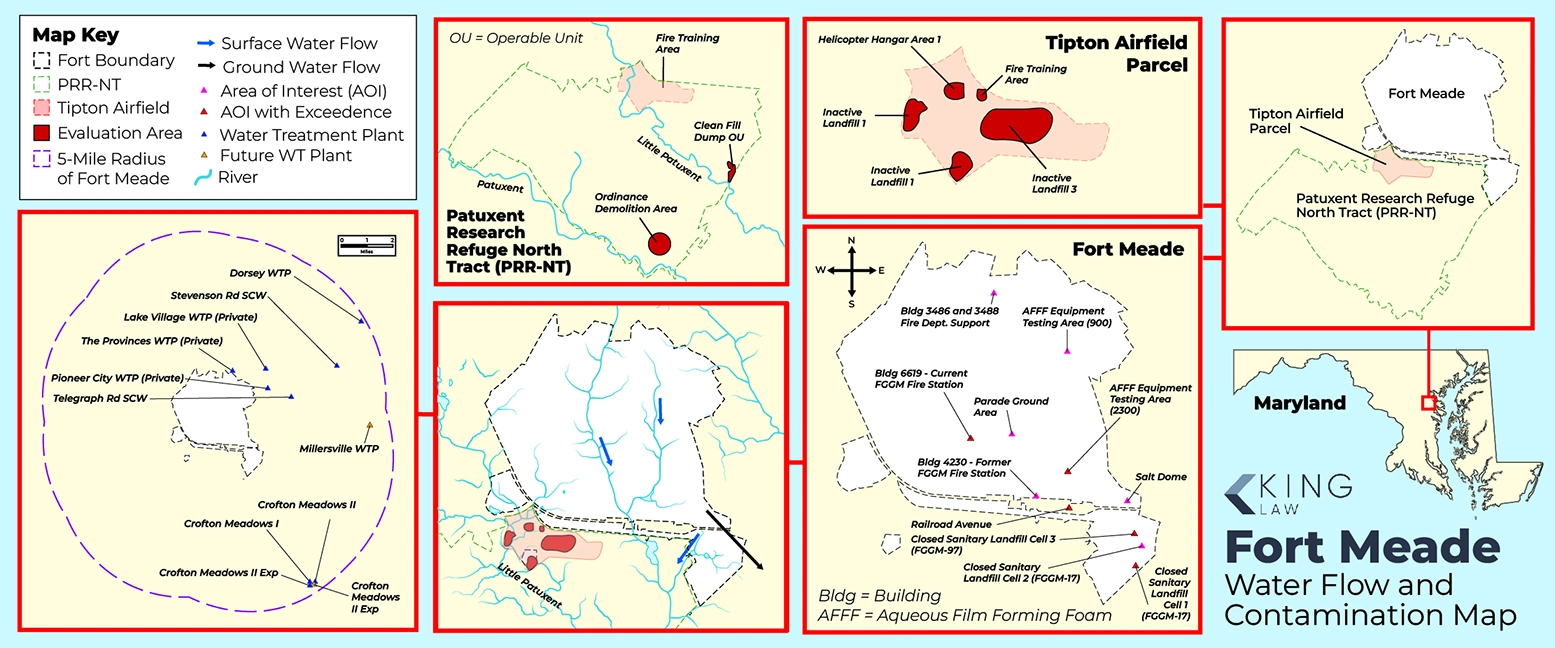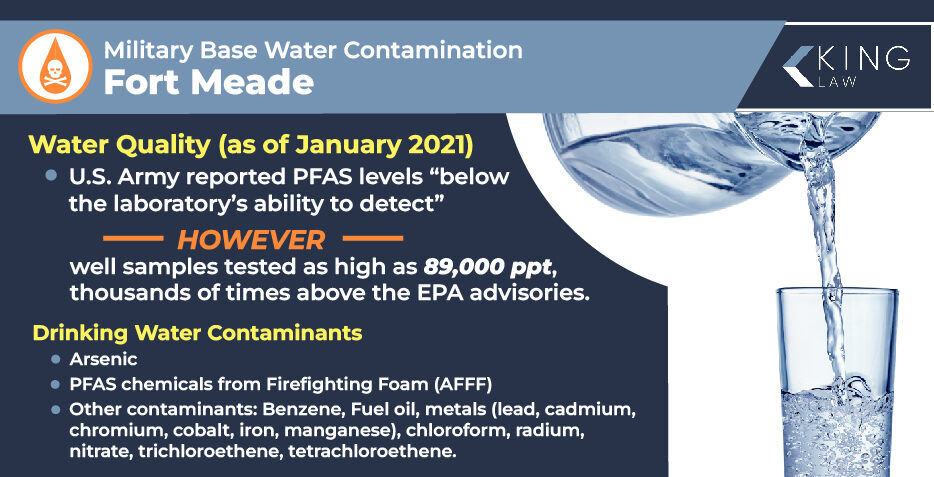
Fort Meade Water Contamination Lawsuit Overview
Fort George G. Meade, originally called Camp Meade, was named after Major General George Gordon Meade, a Union Civil War officer. It was established in 1917 as one of 16 cantonments meant to support the American Expeditionary Forces for World War I. It went on to house the Tank Corps, the Army’s first Cook and Baker’s School, as well as the Special Services Unit Training Center. Today, it’s the base for the National Security Agency, the Defense Information School, the U.S. Cyber Command, and 115 additional agencies.
Fort Meade occupies 13,500 acres of land in Anne Arundel County, Maryland and is positioned along the Little Patuxent and Patuxent Rivers. Unfortunately, the base has been plagued with contamination concerns that have spread to nearby communities. Many of the concerns stem from the use of Aqueous Film Forming Foam (AFFF), a firefighting foam used to contain and put out fires during training exercises or equipment maintenance. This foam contained PFAS, a group of cancer-causing chemicals, that then seeped into the groundwater and impacted drinking water quality on and around the base. Individuals who were affected by PFAS contamination could be eligible to file a lawsuit to hold chemical manufacturers responsible for negligence and associated damages.
Fort Meade Water Contamination Lawsuit Updates
April 2024 – King Law Accepting Fort Meade PFAS Contamination Lawsuits
King Law is reviewing cases from individuals across the country affected by PFAS water contamination at military bases like Fort Meade. Thousands have already filed as more and more claimants seek damages after developing illnesses related to drinking PFAS-contaminated water. Reach out today for a free consultation.
November 2019 – Military Families Sue Over Mold-Infested Living Conditions
In late 2019, multiple military families at Fort Meade filed a lawsuit against a private company they deemed responsible for unsafe living conditions. The families had long-standing, unaddressed concerns about water leaks and sewage backups that led to extensive mold growth. Coupled with contaminated water, these living conditions further elevated the health risks of Fort Meade military families.
December 2008 – Maryland Files Lawsuit Against Army for Lack of Cleanup Efforts
In December 2008, Maryland’s Attorney General, Doug Gansler, sued the United States Army because of delayed efforts to clean up Fort Meade contamination. Gansler requested the Army pass control to the EPA with concerns of groundwater and soil contamination. Supposedly, the Army buried 250 drums of hazardous liquids toward the base’s southern boundary, which started to spread to Patuxent Wildlife Refuge. Army officials reportedly spent $83 million to clean up 33 of 51 contaminated areas at the base.
On this page:
Fort Meade Water Contamination Lawsuit Overview
Fort Meade Water Contamination Lawsuit Updates
Historical Background of Toxic Exposure at Fort Meade
Fort Meade Water Contamination Map
Contaminants Found in Fort Meade Drinking Water
Current Water Quality at Fort Meade
Health Risks Linked to Fort Meade’s Water
Eligibility Criteria for Fort Meade Water Contamination Lawsuit
Fort Meade Water Contamination Settlement Amounts
How to File a Fort Meade Water Contamination Lawsuit
Historical Background of Toxic Exposure at Fort Meade
PFAS has been a major concern for Fort Meade and surrounding communities. Drinking water at and near the base has tested positive for PFAS at very high levels. Keep in mind: Previous EPA health advisories set PFAS limits at 60 ppt but it has since issued interim health advisories for PFOA and PFOS (two types of PFAS chemicals) at 0.004 ppt and 0.02 ppt, respectively.
2023 – Remediation Investigations Underway at Fort Meade
Remediation investigations were listed as “underway” at Fort Meade, meaning additional testing is being done to understand the extent of contamination, risk to the public, and type of remediation needed.
2021 – EPA Requests Remedial Investigation Plan
Due to concerns about PFAS contamination and risk to the public, the EPA requested that the Army conduct a Remedial Investigation plan with a due date of March 21, 2023.
2020 – Groundwater Testing Revealed Extensive PFAS Contamination
Groundwater sampling at Fort Meade took samples from 15 different monitoring wells. PFAS levels were considered very high at several wells located within or near the Helicopter Hangar Area (HHA) and Fire Training Area (FTA). HHA and FTA well results included:
- HHAMW-9 with PFOS at 290 ppt and PFOA at 660 ppt
- HHAMW-11 with PFOS at 450 ppt and PFOA at 140 ppt
- FTAMW-3 with PFOS at 43,000 ppt and PFOA at 3,400 ppt
- FTAMW-7 with PFOS at 13,000 and PFOA at 1,800
2016 – Tipton Airfield Displays High Levels of PFAS Water Contamination
Groundwater around Tipton Airfield was tested in 2016 and returned PFAS contamination levels as high as 89,000 ppt. Concerns arose for the water supplies supporting the Patuxent Wildlife Refuge should the PFAS migrate further from the military base.
2009 – The EPA and Army Identified Multiple Areas In Need of Cleanup Efforts
In 2009, the EPA and the Army took federal action to address contamination concerns at Fort Meade through a Federal Facilities Agreement (FFA). The agreement identified 20 operable units to be addressed with the Superfund program, including the fire training areas, landfills, and areas where pesticides and explosives were used and disposed of. Remediation investigations and efforts have been ongoing since this time with repeated five-year reviews.

Fort Meade Water Contamination Map

This map shows various areas of Fort Meade where firefighting foam was likely used. It also identifies well locations impacted by PFAS contamination. You will see that major areas of concern include the Fire Training Area and Helicopter Hangar Area which are in close proximity to the Little Patuxent River.
- Fire Training Area: The training area was constructed in 1979 for Fort Meade Fire Department training and was an area where they used PFAS-containing firefighting foams.
- Helicopter Hangar Area: The hangar area was constructed in the early 1980s to maintain, repair, and store helicopters. PFAS was found in groundwater near HHA and is attributed to the use of firefighting foam to extinguish flammable liquids.
Contaminants Found in Fort Meade’s Drinking Water
Groundwater at Fort Meade has tested positive for a series of contaminants. Toxins in the groundwater can migrate into drinking water and put consumers at risk. Chemicals of concern at Fort Meade include pesticides, herbicides, fuel oil, metals, PFAS, arsenic, and more.
Per- and Polyfluoroalkyl Substances (PFAS)
PFAS is a group of chemicals linked to multiple different types of cancers and serious health illnesses. PFAS was a component of firefighting foams that the military used to put out and contain fires. For example, it could be sprayed on a training field to extinguish flames, where it would then seep into the ground, contaminate groundwater, and affect drinking water. As a result, military members and their families drank and used water with the cancer-causing chemical.
Arsenic
Arsenic is another groundwater contaminant at Fort Meade. The EPA has investigated arsenic contamination at the Manor View Dump Site, Tipton Airfield, and Cell 3 Landfill. Arsenic in drinking water is linked to diabetes and a higher risk of bladder cancer, lung cancer, liver cancer, and cancer in other organs.
Pesticides and Herbicides
Monitoring of Fort Meade drinking water has also looked at pesticides and herbicides. Chemicals used primarily at the Former Pesticide Shop on the base caused soil and groundwater contamination. Examples noted on the Superfund contamination list include alpha-chlordane, chlordane, lindane, heptachlor, and heptachlor epoxide. These toxins have been linked to cancer, liver issues, and thyroid issues.
Additional Contaminants
Other contaminants of concern at Fort Meade include:
- Benzene
- Fuel oil
- Metals (lead, cadmium, chromium, cobalt, iron, manganese)
- Chloroform
- Radium
- Nitrate
- Trichloroethene
- Tetrachloroethene
Long-term exposure to these contaminants in drinking water is linked to cancer, thyroid disease, liver disease, and a range of other serious side effects and symptoms.
Current Water Quality at Fort Meade
According to the U.S. Army website, the current levels of PFAS at Fort Meade are “below the laboratory’s ability to detect.” These results are based on January 2021 testing. However, well samples tested as high as 43,000 ppt and 89,000 ppt at times, which are thousands of times higher than the EPA’s original health advisories. PFAS is often referred to as “forever chemicals” because they build up in the body and do not break down. So individuals exposed throughout the years are still developing adverse health effects after being stationed at Fort Meade.

Water Treatment Efforts at Fort Meade
Fort Meade has participated in regular water testing throughout the past 2-3 decades, seeking to identify and warn the public of any toxins in drinking water. Groundwater is disinfected with sodium hypochlorite but remedial investigations are still underway to determine any additional cleanup efforts.
Health Risks Linked to Fort Meade’s Water
Individuals at Fort Meade who were exposed to PFAS-contaminated water may be at risk of developing the following illnesses:
- Testicular cancer
- Pancreatic cancer
- Kidney cancer
- Thyroid cancer
- Other thyroid issues
- Birth defects
- Changes in liver enzymes
- Neurological disorders
- Respiratory illnesses
- Lower vaccine effectiveness
Our law firm is currently evaluating cases where individuals have been diagnosed with:
- Bladder Cancer
- Breast Cancer
- Hodgkin’s Lymphoma
- Kidney Cancer
- Leukemia
- Liver cancer
- Multiple-Myeloma
- Non-Hodgkin’s Lymphoma
- Pancreatic Cancer
- Prostate Cancer
- Testicular Cancer
- Thyroid Cancer
- Thyroid Disease
- Ulcerative Colitis
If you have any symptoms related to water contamination, seek medical care as soon as possible. You should also notify your healthcare provider of previous exposure for proactive monitoring of related conditions.
Eligibility Criteria for Fort Meade Water Contamination Lawsuit
You could be eligible for compensation if you were exposed to contaminated drinking water at Fort Meade and developed a related illness. Contact us as soon as possible to review the details of your case and confirm your eligibility. We typically look for two main things:
- Acceptable exposure duration: We usually look for at least six months of exposure to toxins at a military base like Fort Meade. Duration of exposure is crucial to building a solid case and with PFAS, the chemicals build up in your body over time and long-term exposure increases your health risks.
- Related diagnosis: You will need proof that you’ve been diagnosed with an illness related to toxic exposure. We are looking at cases that involve bladder cancer, breast cancer, Hodgkin’s and non-Hodgkin’s lymphoma, kidney cancer, leukemia, prostate cancer, testicular cancer, thyroid cancer, thyroid disease, ulcerative colitis, etc.
Our law firm is currently evaluating cases where individuals have been diagnosed with:
- Bladder Cancer
- Breast Cancer
- Hodgkin’s Lymphoma
- Kidney Cancer
- Leukemia
- Liver cancer
- Multiple-Myeloma
- Non-Hodgkin’s Lymphoma
- Pancreatic Cancer
- Prostate Cancer
- Testicular Cancer
- Thyroid Cancer
- Thyroid Disease
- Ulcerative Colitis
This information will help solidify your case against PFAS or other chemical manufacturers you deem responsible for your exposure and related illness. Be prepared to provide evidence like military assignments, discharge paperwork, medical records, and more to substantiate your claim. Rest assured, we will guide you through the entire process from start to finish.
Fort Meade Water Contamination Settlement Amounts
We anticipate water contamination lawsuits to settle with payouts around $30,000-$500,000. Previous lawsuits of this nature have settlements between $100,000 and $350,000 with an average payout of $250,000.
Actual payouts will vary based on the specifics of your case. Details like longer-term exposure and a diagnosis of a very severe illness may result in higher payouts, extending toward $1,000,000. Cases that lack evidence, have short-term exposure, or don’t involve a very serious illness could fall on the shorter end at $30,000-$75,000. Your attorney could recommend going to trial, but you do risk walking away with no compensation if the verdict is not in your favor.
How to File a Fort Meade Water Contamination Lawsuit
To file a Fort Meade water contamination lawsuit, consider the following steps:
- Reach out to an attorney who has a background in environmental law and toxic torts. We can provide you with an initial consultation to review your case and confirm your eligibility.
- Give your attorney any evidence you have regarding when you were stationed at Fort Meade, what toxins you were exposed to, how long you were exposed, what you were diagnosed with, and what damages you’ve faced.
- Your attorney will draft and file your complaint with the appropriate court, naming the responsible party and providing details needed to propel the success of your claim.
- You may be presented with the option to settle, in which case your attorney can negotiate on your behalf to get the most compensation possible. Again, they may recommend you pursue a verdict, but this process can take longer and impact your ability to get any financial reward.
- With a successful case, you will then get compensation for lost wages, treatment costs, and other resulting damages.
Evidence Needed to Support Your Fort Meade Claim
Evidence is detrimental to the success of your PFAS claim. Documentation that can improve your case includes:
- Medical records confirming details of your diagnosis
- Additional information regarding your prognosis
- Copies of military orders, deployment records, discharge paperwork, and any other files showing when you were at Fort Meade during times when the drinking water was contaminated
- Studies, reports, and other reliable sources articulating the nature of toxic exposure at Fort Meade and related health risks
- Any other information requested by your attorney to round out your claim
Don’t delay in reaching out to an attorney. And keep in mind, experience is crucial to the strength and success of your case.
Statute of Limitations for Fort Meade Water Contamination Claims
Statutes of limitations are deadlines that establish when you must file a lawsuit. These timelines vary based on the state in which you file as well as the type of claim. To ensure you don’t limit or lose your chances at compensation, consult with an attorney to file as soon as possible.
Fort Meade Water Contamination Lawyers
Claims that involve toxic exposure at military bases are unique. At King Law, we have the background, resources, and expertise needed to successfully navigate and win water contamination lawsuits. We provide compassion, support, understanding, and drive to get you the compensation you deserve in a timely manner. Reach out today to get started.
Frequently Asked Questions (FAQs)
For additional information about Fort Meade water contamination, refer to the following answers to frequently asked questions.

